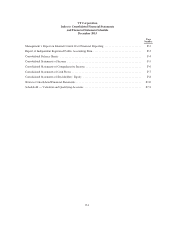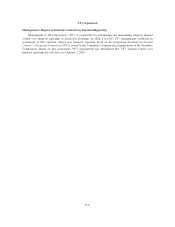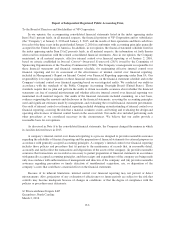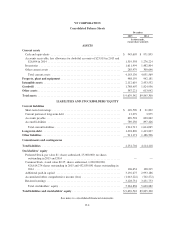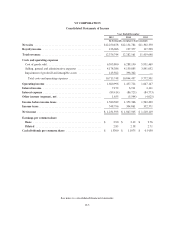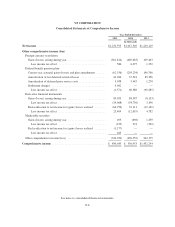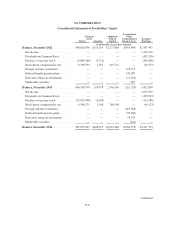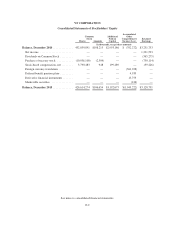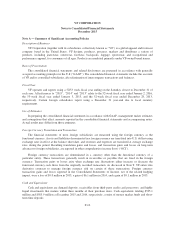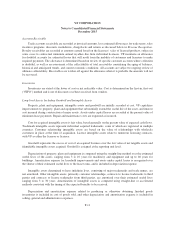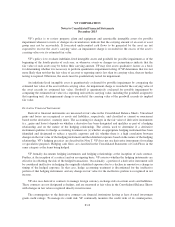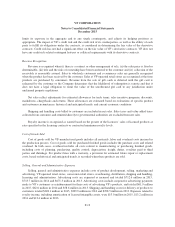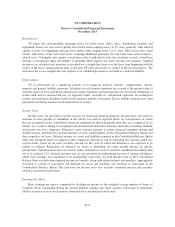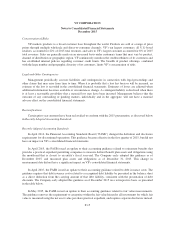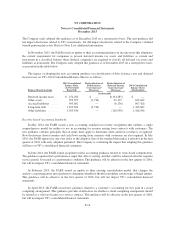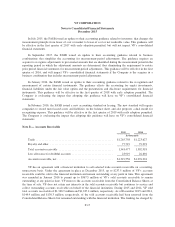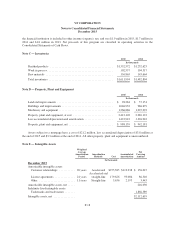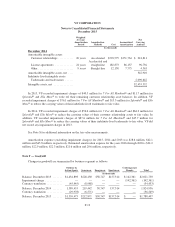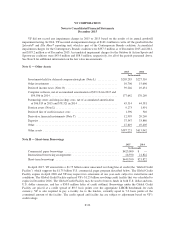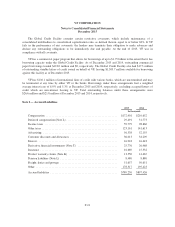North Face 2015 Annual Report Download - page 87
Download and view the complete annual report
Please find page 87 of the 2015 North Face annual report below. You can navigate through the pages in the report by either clicking on the pages listed below, or by using the keyword search tool below to find specific information within the annual report.VF CORPORATION
Notes to Consolidated Financial Statements
December 2015
Accounts Receivable
Trade accounts receivable are recorded at invoiced amounts, less estimated allowances for trade terms, sales
incentive programs, discounts, markdowns, chargebacks and returns as discussed below in Revenue Recognition.
Royalty receivables are recorded at amounts earned based on the licensees’ sales of licensed products, subject in
some cases to contractual minimum annual royalties due from individual licensees. VF maintains an allowance
for doubtful accounts for estimated losses that will result from the inability of customers and licensees to make
required payments. The allowance is determined based on review of specific customer accounts where collection
is doubtful, as well as an assessment of the collectability of total receivables considering the aging of balances,
historical and anticipated trends, and current economic conditions. All accounts are subject to ongoing review of
ultimate collectability. Receivables are written off against the allowance when it is probable the amounts will not
be recovered.
Inventories
Inventories are stated at the lower of cost or net realizable value. Cost is determined on the first-in, first-out
(“FIFO”) method and is net of discounts or rebates received from vendors.
Long-lived Assets, Including Goodwill and Intangible Assets
Property, plant and equipment, intangible assets and goodwill are initially recorded at cost. VF capitalizes
improvements to property, plant and equipment that substantially extend the useful life of the asset, and interest
cost incurred during construction of major assets. Assets under capital leases are recorded at the present value of
minimum lease payments. Repair and maintenance costs are expensed as incurred.
Cost for acquired intangible assets is fair value, based generally on the present value of expected cash flows.
Trademark intangible assets represent individual acquired trademarks, some of which are registered in multiple
countries. Customer relationship intangible assets are based on the value of relationships with wholesale
customers in place at the time of acquisition. License intangible assets relate to numerous licensing contracts,
with VF as either the licensor or licensee.
Goodwill represents the excess of cost of an acquired business over the fair value of net tangible assets and
identifiable intangible assets acquired. Goodwill is assigned at the reporting unit level.
Depreciation of property, plant and equipment is computed using the straight-line method over the estimated
useful lives of the assets, ranging from 3 to 10 years for machinery and equipment and up to 40 years for
buildings. Amortization expense for leasehold improvements and assets under capital leases is recognized over
the shorter of their estimated useful lives or the lease terms, and is included in depreciation expense.
Intangible assets determined to have indefinite lives, consisting of major trademarks and trade names, are
not amortized. Other intangible assets, primarily customer relationships, contracts to license trademarks to third
parties and contracts to license trademarks from third parties, are amortized over their estimated useful lives
ranging from 3 to 30 years. Amortization of intangible assets is computed using straight-line or accelerated
methods consistent with the timing of the expected benefits to be received.
Depreciation and amortization expense related to producing or otherwise obtaining finished goods
inventories is included in cost of goods sold, and other depreciation and amortization expense is included in
selling, general and administrative expenses.
F-11


